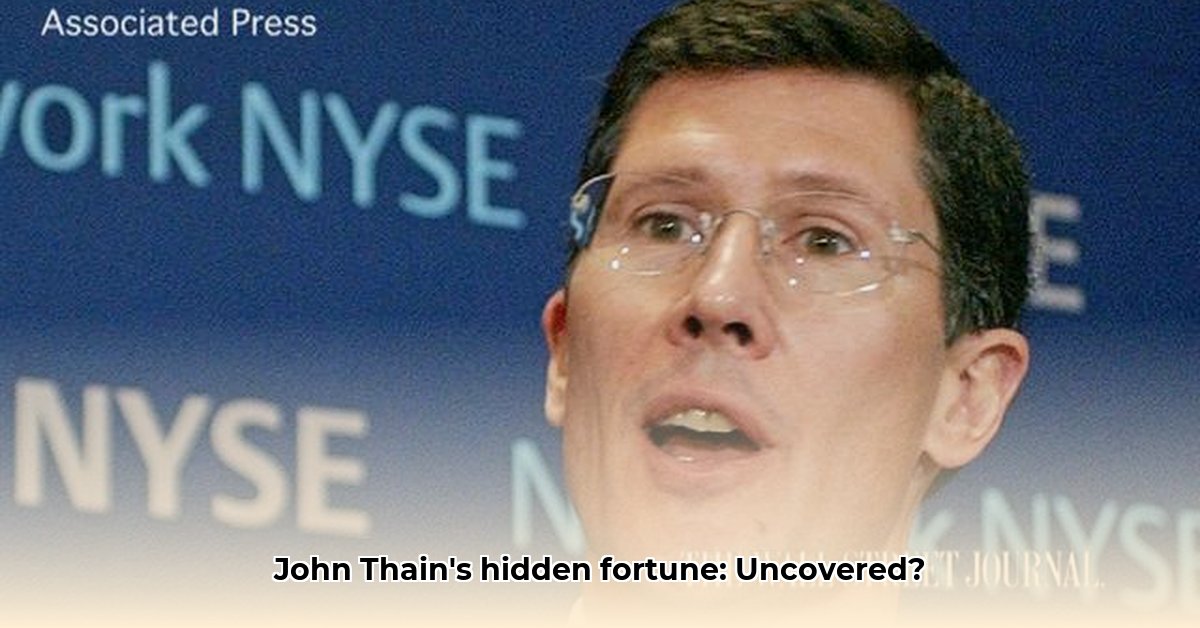
Unraveling the Financial Enigma of John Thain's Fortune
John Thain, a prominent figure in the financial world, has seen his estimated net worth fluctuate dramatically, ranging from $100 million to a staggering $1.2 billion. This significant discrepancy underscores the inherent challenges in accurately assessing the wealth of ultra-high-net-worth individuals (UHNWIs). This article delves into the methodologies used to estimate Thain's net worth, the factors contributing to the discrepancies, and the broader implications for various stakeholders.
The Discrepancy in Reported Net Worth: A Closer Look
Estimates of John Thain's net worth vary wildly, reflecting the inherent difficulties in accurately assessing the wealth of individuals with complex and diverse financial holdings. Conservative estimates, based primarily on publicly available information such as salary and known investments, tend toward the lower end of the spectrum. More ambitious estimations, incorporating potentially significant holdings in privately held assets and fluctuating stock values, reach considerably higher figures. This substantial gap highlights the limitations of relying solely on publicly accessible data for accurate estimations.
Methodologies and Their Limitations: A Critical Analysis
Two primary methodologies are employed to estimate net worth: biographical assessments and asset-based valuations. Biographical approaches reconstruct a financial history using publicly available information like salary, bonuses, and documented investments. This method, however, often underestimates total wealth due to the exclusion of privately held assets and less easily traceable investments. Asset-based valuations, on the other hand, attempt to quantify the total value of all assets. Yet, this method suffers from the inherent volatility of market values and the lack of readily available data on privately held assets, resulting in fluctuating and imprecise estimations. Websites like Celebrity Net Worth and GuruFocus, while providing insights, rely on similar publicly accessible information and should be viewed as estimates, not definitive financial statements.
Key Factors Contributing to the Discrepancy: A Deep Dive
Several factors significantly impact the accuracy of net worth estimations:
Privately Held Assets: A substantial portion of UHNWIs' wealth resides in privately held companies, real estate holdings, and other less liquid assets. Valuing these assets requires complex appraisals and subjective judgments, making precise quantification challenging. The lack of transparency makes it virtually impossible to arrive at a definitive figure.
Fluctuating Asset Values: Market volatility introduces inherent uncertainty. The value of publicly traded stocks and other investments can change dramatically in short periods, rendering any point-in-time estimate subject to considerable variability. A net worth calculated today might vary significantly tomorrow.
Lack of Transparency: UHNWIs are not obligated to publicly disclose their entire financial portfolio. This inherent lack of transparency presents a significant barrier to accurate assessment, creating significant gaps in available data. Even with exhaustive research, a truly complete picture may remain elusive.
Stakeholder Analysis: Implications and Actionable Intelligence
The uncertainty surrounding John Thain's net worth has broad implications for several stakeholder groups:
Financial Researchers: Inaccurate net worth data hinders robust research on wealth distribution and economic inequality. More precise methodologies and greater transparency are crucial for credible analysis.
Journalists: Accurate reporting on the finances of prominent individuals requires reliable data. The wide range of estimates for John Thain highlights the challenges of accurate financial reporting and provides a clear demonstration of the complexities in this realm.
Investors: Understanding the financial health of company leaders can inform investment decisions. The uncertainty surrounding net worth can create challenges in assessing potential conflicts of interest and evaluating investment decisions.
Tax Authorities: Accurate net worth figures are fundamental for fair tax assessment. The difficulty in obtaining comprehensive data creates challenges in ensuring equitable tax liabilities.
Conclusion: The Ongoing Challenge of Accurate Wealth Assessment
Determining the precise net worth of UHNWIs remains a significant challenge. The wide range of estimates for John Thain's fortune exemplifies the limitations of current methodologies and the inherent complexities of global financial systems. Greater transparency in financial reporting, combined with more robust regulatory oversight, is necessary to improve the accuracy of wealth assessments and address the broader implications for research, journalism, investment, and tax policy. Until then, reported net worth figures should be considered educated estimates, not definitive financial statements. This article aims to shed light on the complexities of this ongoing challenge.